 Facebook
Facebook
 X
X
 Instagram
Instagram
 TikTok
TikTok
 Youtube
Youtube
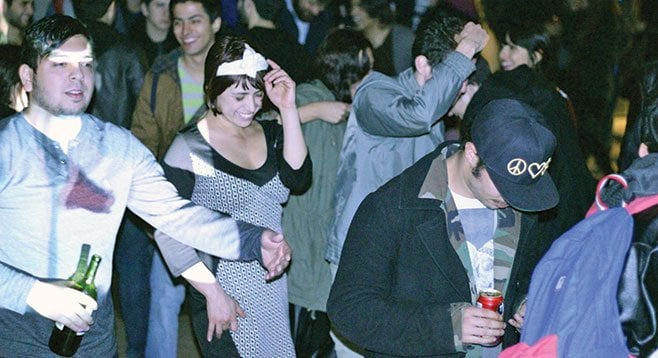
For a party dubbed “El Futuro,” the Tijuana-modern house situated above the Caliente greyhound track felt perfect. The façade’s dominant feature — a series of angled mirror-windows — echoed the outside swath of streetlights and partygoers in warped, otherworldly segments that self-morphed like an ominous mushroom vision.
Accordingly, the all-night electronic exposé saw sets from Tijuana luminaries, such as members of Los Macuanos, Santos, and María y José — all ambassadors of the city’s “ruidosón movement.”
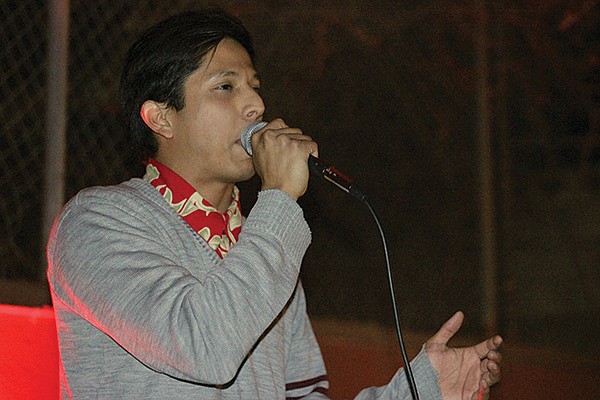
As much an augury of Tijuana’s bleak future as it is a meditation on the broken promises of an industrialized maquiladora-polis, ruidosón is a post narco-war retort to the optimistic anthems of Nortec Collective.
Where Nortec warmed the gut like a shot of electric mezcal, ruidosón is a portentous bellyful of eclectic mescaline. Suspicion and doom lurk beneath every beat.
“Nortec founded a very aesthetic vision of Tijuana,” Dorian Santos tells me after his midnight set. “All we want to do is reveal the dark side of Tijuana.”
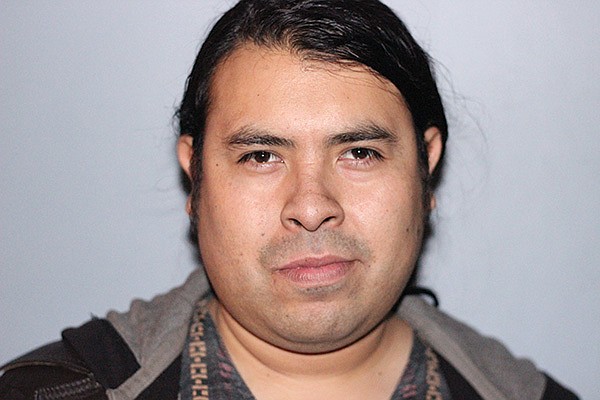
You wouldn’t guess it by watching the hundred or so locals shaking ass to his electro cumbia, but Santos is at the forefront of musical realism in Tijuana, and what he sees isn’t pretty.
“Tijuana has violence. Tijuana has bad people. There are narcos, human traffickers, lots of problems. Tijuana is not happy,” he says, countering Nortec’s canonical refrain, “Tijuana Makes Me Happy.”
Rather, ruidosón posits, “Tijuana makes me paranoid, but there’s a pulse beneath the pandemonium.”
Mercurial by nature, ruidosón reimagines Mexican cumbia and Afro-Cuban rhythms through the binary beatwork of techno, minimal house, doombia, hip-hop, ambient, and krautrock.
And, while largely influenced by Monterrey’s 3Ball MTY crew, ruidosón trades the peacockish pointy boots of tribal guarachero for urban shit-kickers with steel toes and power laces. Ruidosón is dystopia you can dance to.
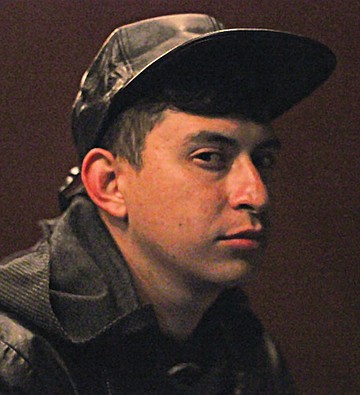
“Ruidosón is a movement that Moisés Horta of Los Macuanos and I did over the internet,” say Tonys Gallardo II, who performs as María y José. “It’s just a name-drop we did, like, five years ago, and then we decided to name it after a genre we made, but it’s not a genre. It’s a mix of a lot of things.”
Among them, Gallardo acknowledges El Guincho, Discos Fuentes, Los Temerarios, Los Bukis, Los Fugitivos, and Selena.
“Ruidosón is a mix of all the cumbia rhythms that have been remixed, plus our own touch,” says Gallardo, “which is these lyrics about violence, hypocrisy, and the bad government we have in Mexico. It’s criticism. It’s prophecy. I’m the fucking Machiavelli of ruidosón.”
Even so, Gallardo is quick to admit, “I’m not the greatest producer of ruidosón. Siete Catorce is. He’s a fucking genius. I’m just the prophet.”
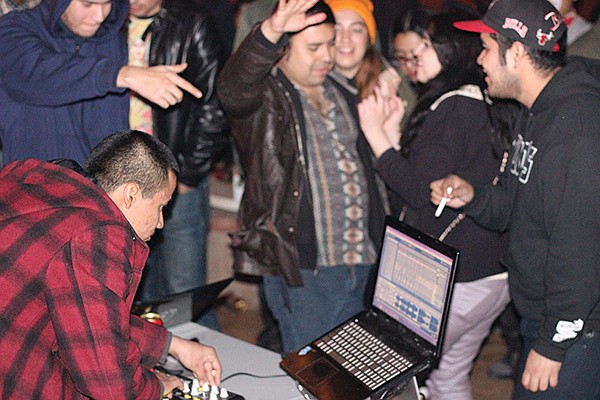
Siete Catorce (aka Den5ion aka Sin Amigos) grew up in Oakland and moved back to his birthplace of Mexicali in 2007. The Luke Skywalker to Gallardo’s Obiwan, Siete draws on his hip-hop upbringing in the Bay Area, the experimental undercurrents of Baja’s capital (see: Tron, Fax, Vampire Slayer, Letters From Readers), his camaraderie with the NAAFI crew in Mexico City (with whom he released his first EP), and his own bedroom meddling in glitch and bass.
“Everyone has a reason to be depressed but they ignore it,” Siete says, “so I’m trying to get people to acknowledge it and dance to it. It’s the only way to continue progressing, to bring the positive out of it.”
By now it’s around 5:30 a.m. and the police want us to turn the sound off. Instead, TJ ambient beat trio Siberium turns it down and we make the best of the predawn disarray.


For a party dubbed “El Futuro,” the Tijuana-modern house situated above the Caliente greyhound track felt perfect. The façade’s dominant feature — a series of angled mirror-windows — echoed the outside swath of streetlights and partygoers in warped, otherworldly segments that self-morphed like an ominous mushroom vision.
Accordingly, the all-night electronic exposé saw sets from Tijuana luminaries, such as members of Los Macuanos, Santos, and María y José — all ambassadors of the city’s “ruidosón movement.”

As much an augury of Tijuana’s bleak future as it is a meditation on the broken promises of an industrialized maquiladora-polis, ruidosón is a post narco-war retort to the optimistic anthems of Nortec Collective.
Where Nortec warmed the gut like a shot of electric mezcal, ruidosón is a portentous bellyful of eclectic mescaline. Suspicion and doom lurk beneath every beat.
“Nortec founded a very aesthetic vision of Tijuana,” Dorian Santos tells me after his midnight set. “All we want to do is reveal the dark side of Tijuana.”

You wouldn’t guess it by watching the hundred or so locals shaking ass to his electro cumbia, but Santos is at the forefront of musical realism in Tijuana, and what he sees isn’t pretty.
“Tijuana has violence. Tijuana has bad people. There are narcos, human traffickers, lots of problems. Tijuana is not happy,” he says, countering Nortec’s canonical refrain, “Tijuana Makes Me Happy.”
Rather, ruidosón posits, “Tijuana makes me paranoid, but there’s a pulse beneath the pandemonium.”
Mercurial by nature, ruidosón reimagines Mexican cumbia and Afro-Cuban rhythms through the binary beatwork of techno, minimal house, doombia, hip-hop, ambient, and krautrock.
And, while largely influenced by Monterrey’s 3Ball MTY crew, ruidosón trades the peacockish pointy boots of tribal guarachero for urban shit-kickers with steel toes and power laces. Ruidosón is dystopia you can dance to.

“Ruidosón is a movement that Moisés Horta of Los Macuanos and I did over the internet,” say Tonys Gallardo II, who performs as María y José. “It’s just a name-drop we did, like, five years ago, and then we decided to name it after a genre we made, but it’s not a genre. It’s a mix of a lot of things.”
Among them, Gallardo acknowledges El Guincho, Discos Fuentes, Los Temerarios, Los Bukis, Los Fugitivos, and Selena.
“Ruidosón is a mix of all the cumbia rhythms that have been remixed, plus our own touch,” says Gallardo, “which is these lyrics about violence, hypocrisy, and the bad government we have in Mexico. It’s criticism. It’s prophecy. I’m the fucking Machiavelli of ruidosón.”
Even so, Gallardo is quick to admit, “I’m not the greatest producer of ruidosón. Siete Catorce is. He’s a fucking genius. I’m just the prophet.”

Siete Catorce (aka Den5ion aka Sin Amigos) grew up in Oakland and moved back to his birthplace of Mexicali in 2007. The Luke Skywalker to Gallardo’s Obiwan, Siete draws on his hip-hop upbringing in the Bay Area, the experimental undercurrents of Baja’s capital (see: Tron, Fax, Vampire Slayer, Letters From Readers), his camaraderie with the NAAFI crew in Mexico City (with whom he released his first EP), and his own bedroom meddling in glitch and bass.
“Everyone has a reason to be depressed but they ignore it,” Siete says, “so I’m trying to get people to acknowledge it and dance to it. It’s the only way to continue progressing, to bring the positive out of it.”
By now it’s around 5:30 a.m. and the police want us to turn the sound off. Instead, TJ ambient beat trio Siberium turns it down and we make the best of the predawn disarray.
Comments